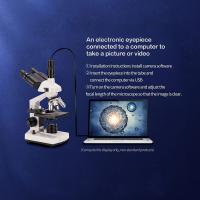Why Are Microscopes Useful Tools In Biology ?
Microscopes are useful tools in biology because they allow scientists to observe and study objects that are too small to be seen with the naked eye. They enable the visualization of cells, tissues, and microorganisms, providing valuable insights into their structure, function, and behavior. Microscopes allow scientists to explore the intricate details of biological specimens, such as the internal structures of cells, the arrangement of tissues, and the interactions between different organisms. By magnifying the image, microscopes enhance the resolution and clarity of the specimen, enabling scientists to make accurate observations and measurements. This helps in understanding various biological processes, such as cell division, growth, and differentiation. Microscopes also play a crucial role in medical research, as they aid in the diagnosis and study of diseases, identification of pathogens, and development of new treatments. Overall, microscopes are indispensable tools in biology, enabling scientists to unlock the mysteries of the microscopic world.
1、 Magnification: Enlarging objects for detailed observation in biology.
Microscopes are incredibly useful tools in biology due to their ability to magnify objects for detailed observation. Magnification is a fundamental aspect of microscopy that allows scientists to study biological specimens at a level of detail that would otherwise be impossible to achieve with the naked eye.
One of the primary reasons why microscopes are essential in biology is their ability to reveal the intricate structures and features of cells and tissues. By magnifying these structures, scientists can study the morphology and organization of cells, which is crucial for understanding their functions and processes. For example, microscopes have been instrumental in identifying and characterizing organelles within cells, such as the nucleus, mitochondria, and endoplasmic reticulum.
Moreover, microscopes enable scientists to observe and analyze microorganisms, such as bacteria and viruses, which are often too small to be seen without magnification. This is particularly important in the field of microbiology, where the study of these microorganisms is essential for understanding diseases, developing treatments, and advancing our knowledge of the microbial world.
In recent years, advancements in microscopy technology have further enhanced the usefulness of microscopes in biology. For instance, the development of electron microscopy has allowed scientists to achieve even higher levels of magnification, enabling the visualization of structures at the nanoscale. This has opened up new avenues of research, such as the study of molecular interactions and the investigation of cellular processes at an unprecedented level of detail.
In conclusion, microscopes are indispensable tools in biology due to their ability to magnify objects for detailed observation. They have revolutionized our understanding of cells, tissues, and microorganisms, and continue to play a crucial role in advancing biological research. With ongoing technological advancements, microscopes are likely to remain at the forefront of scientific discovery in the field of biology.

2、 Resolution: Enhancing clarity and distinguishing fine details in biological specimens.
Microscopes are incredibly useful tools in biology due to their ability to enhance clarity and distinguish fine details in biological specimens. The resolution provided by microscopes allows scientists to observe and study structures at a level that would otherwise be impossible to see with the naked eye.
One of the primary advantages of microscopes is their ability to magnify specimens, enabling scientists to examine cells, tissues, and even individual molecules. This magnification allows for the visualization of intricate structures and the identification of specific cellular components. By observing these fine details, scientists can gain a deeper understanding of biological processes and mechanisms.
Furthermore, microscopes provide a level of resolution that enhances the clarity of the observed specimens. This increased clarity allows scientists to differentiate between different structures and identify subtle changes or abnormalities. For example, in medical research, microscopes are used to identify cancer cells or pathogens in patient samples, aiding in diagnosis and treatment.
In recent years, advancements in microscopy techniques have further expanded the capabilities of these tools. For instance, confocal microscopy and super-resolution microscopy techniques have revolutionized the field by providing even higher resolution and three-dimensional imaging. These techniques have allowed scientists to study cellular processes in unprecedented detail, leading to new discoveries and insights.
In conclusion, microscopes are indispensable tools in biology due to their ability to enhance clarity and distinguish fine details in biological specimens. The resolution provided by microscopes enables scientists to observe structures at a microscopic level, leading to a deeper understanding of biological processes. With the continuous advancements in microscopy techniques, these tools will continue to play a crucial role in driving scientific discoveries and advancements in the field of biology.

3、 Cell Structure: Revealing the intricate components and organelles within cells.
Microscopes are incredibly useful tools in biology because they allow scientists to reveal the intricate components and organelles within cells. By magnifying the microscopic world, microscopes enable researchers to study the structure and function of cells in great detail.
One of the primary reasons microscopes are essential in biology is their ability to visualize cell structure. Cells are the building blocks of life, and understanding their structure is crucial for comprehending how they function. Microscopes allow scientists to observe the various organelles within cells, such as the nucleus, mitochondria, and endoplasmic reticulum. This knowledge is fundamental for studying cellular processes, including DNA replication, protein synthesis, and energy production.
Moreover, microscopes have evolved over time, providing scientists with more advanced imaging techniques. For instance, electron microscopes use a beam of electrons instead of light, allowing for even higher magnification and resolution. This advancement has revolutionized our understanding of cell structure, enabling scientists to visualize subcellular components with unprecedented detail. Electron microscopy has been instrumental in uncovering the intricate architecture of organelles and the complex interactions between molecules within cells.
Furthermore, microscopes have played a crucial role in the development of fields such as microbiology and immunology. Microscopes have allowed scientists to observe and study microorganisms, such as bacteria and viruses, which are invisible to the naked eye. This has led to significant advancements in our understanding of infectious diseases and the development of vaccines and antibiotics.
In recent years, advancements in microscopy techniques have further expanded the capabilities of microscopes. For example, confocal microscopy and super-resolution microscopy techniques have enabled scientists to visualize cellular processes in real-time and at nanoscale resolution. These techniques have provided insights into dynamic cellular events, such as cell division, intracellular signaling, and protein interactions.
In conclusion, microscopes are indispensable tools in biology due to their ability to reveal the intricate components and organelles within cells. They have allowed scientists to study cell structure, understand cellular processes, and advance fields such as microbiology and immunology. With ongoing advancements in microscopy techniques, microscopes continue to play a vital role in unraveling the mysteries of life at the cellular level.

4、 Microorganisms: Studying microscopic life forms crucial to understanding biology.
Microscopes are incredibly useful tools in biology because they allow scientists to study and observe microorganisms, which are crucial to understanding the field of biology as a whole. Microorganisms, such as bacteria, viruses, and fungi, are microscopic life forms that play a significant role in various biological processes and ecosystems.
One of the primary reasons why microscopes are essential in studying microorganisms is that they enable scientists to visualize these tiny organisms. Microorganisms are too small to be seen with the naked eye, and without the use of microscopes, their existence and characteristics would remain hidden. By magnifying the image of microorganisms, scientists can observe their structure, behavior, and interactions with other organisms. This knowledge is fundamental in understanding the basic principles of biology, such as cell structure and function, reproduction, and evolution.
Moreover, microscopes allow scientists to identify and classify different types of microorganisms. By examining their morphological features, such as shape, size, and arrangement, scientists can categorize microorganisms into different groups and species. This classification is crucial for studying the diversity and evolution of microorganisms, as well as for identifying potential pathogens and understanding their impact on human health and the environment.
In recent years, advancements in microscopy techniques have further enhanced the usefulness of microscopes in biology. For example, the development of electron microscopy has allowed scientists to visualize microorganisms at an even higher resolution, revealing intricate details of their internal structures. Additionally, fluorescence microscopy techniques have enabled scientists to label specific molecules or structures within microorganisms, providing insights into their functions and interactions.
In conclusion, microscopes are indispensable tools in biology because they enable scientists to study and understand microorganisms. By visualizing and classifying these microscopic life forms, scientists can gain valuable insights into the fundamental principles of biology, as well as their roles in various biological processes and ecosystems. The continuous advancements in microscopy techniques further enhance the usefulness of microscopes, allowing for more detailed and comprehensive studies of microorganisms.






































